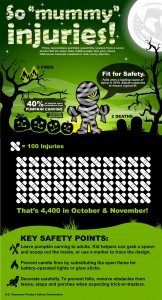No tricks – we want you to have a safe Halloween!
October 27, 2015During the Halloween season, the most frightening thing we can think of is a trick-or-treater getting hurt. So please, before your little pumpkins head out to scare up some candy, take some time to make sure they’ve got safety in the bag first. The U.S. Consumer Product Safety Commission has a great collection of tips to get you started:
- Treats: Warn children not to eat any treats before an adult has carefully examined them for evidence of tampering.
- Flame Resistant Costumes: When purchasing a costume, masks, beards, and wigs, look for the label Flame

Click on the picture for more safety tips
Resistant. Although this label does not mean these items won’t catch fire, it does indicate the items will resist burning and should extinguish quickly once removed from the ignition source. To minimize the risk of contact with candles or other sources of ignition, avoid costumes made with flimsy materials and outfits with big, baggy sleeves or billowing skirts. - Costume Designs: Purchase or make costumes that are light and bright enough to be clearly visible to motorists.
- For greater visibility during dusk and darkness, decorate or trim costumes with reflective tape that will glow in the beam of a car’s headlights. Bags or sacks should also be light colored or decorated with reflective tape. Reflective tape is usually available in hardware, bicycle, and sporting goods stores.
- To easily see and be seen, children should also carry flashlights.
- Costumes should be short enough to prevent children from tripping and falling.
- Children should wear well-fitting, sturdy shoes . Mother’ s high heels are not a good idea for safe walking.
- Hats and scarfs should be tied securely to prevent them from slipping over children’s eyes.
- Apply a natural mask of cosmetics rather than have a child wear a loose-fitting mask that might restrict breathing or obscure vision. If a mask is used, however, make sure it fits securely and has eyeholes large enough to allow full vision.
- Swords, knives, and similar costume accessories should be of soft and flexible material.
- Pedestrian Safety: Young children should always be accompanied by an adult or an older, responsible child. All children should WALK, not run from house to house and use the sidewalk if available, rather than walk in the street. Children should be cautioned against running out from between parked cars, or across lawns and yards where ornaments, furniture, or clotheslines present dangers.
- Choosing Safe Houses: Children should go only to homes where the residents are known and have outside lights on as a sign of welcome.
- Children should not enter homes or apartments unless they are accompanied by an adult.
- People expecting trick-or-treaters should remove anything that could be an obstacle from lawns, steps and porches. Candlelit jack-o’-lanterns should be kept away from landings and doorsteps where costumes could brush against the flame. Indoor jack-o’-lanterns should be kept away from curtains, decorations, and other furnishings that could be ignited.
It’s not just our children who need protecting from things that go bump in the night. Our pets are at risk, too. The ASPCA has put together some guidelines to keep your four-footed little monsters safe, too:
“1. No tricks, no treats: That bowl of candy is for trick-or-treaters, not for Scruffy and Fluffy. Chocolate in all forms—especially dark or baking chocolate—can be very dangerous for dogs and cats. Candies containing the artificial sweetener xylitol can also cause problems. If you do suspect your pet has ingested something toxic, please call your veterinarian or the ASPCA Animal Poison Control Center at (888) 426-4435.
2. Popular Halloween plants such as pumpkins and decorative corn are considered to be relatively nontoxic, but they can produce stomach upset in pets who nibble on them.
3. Wires and cords from electric lights and other decorations should be kept out of reach of your pets. If chewed, your pet might suffer cuts or burns, or receive a possibly life-threatening electrical shock.
4. A carved pumpkin certainly is festive, but do exercise caution if you choose to add a candle. Pets can easily knock a lit pumpkin over and cause a fire. Curious kittens especially run the risk of getting burned or singed by candle flames.
5. Dress-up can be a big mess-up for some pets. Please don’t put your dog or cat in a costume UNLESS you know he or she loves it (yup, a few pets are real hams!). For pets who prefer their “birthday suits,” however, wearing a costume may cause undue stress.
6. If you do dress up your pet, make sure the costume isn’t annoying or unsafe. It should not constrict the animal’s movement or hearing, or impede his ability to breathe, bark or meow. Also, be sure to try on costumes before the big night. If your pet seems distressed, allergic or shows abnormal behavior, consider letting him go au naturale or donning a festive bandana.
7. Take a closer look at your pet’s costume and make sure it does not have small, dangling or easily chewed-off pieces that he could choke on. Also, ill-fitting outfits can get twisted on external objects or your pet, leading to injury.
8. All but the most social dogs and cats should be kept in a separate room away from the front door during peak trick-or-treating hours. Too many strangers can be scary and stressful for pets.
9. When opening the door for trick-or-treaters, take care that your cat or dog doesn’t dart outside.
10. IDs, please! Always make sure your dog or cat has proper identification. If for any reason your pet escapes and becomes lost, a collar and tags and/or a microchip can be a lifesaver, increaing the chances that he or she will be returned to you.”